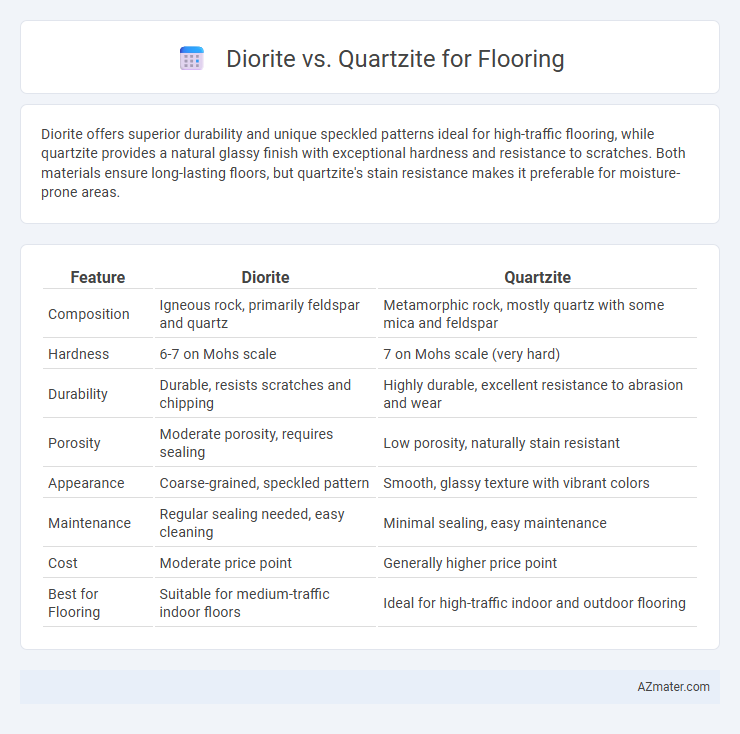Diorite offers superior durability and unique speckled patterns ideal for high-traffic flooring, while quartzite provides a natural glassy finish with exceptional hardness and resistance to scratches. Both materials ensure long-lasting floors, but quartzite's stain resistance makes it preferable for moisture-prone areas.
Table of Comparison
| Feature | Diorite | Quartzite |
|---|---|---|
| Composition | Igneous rock, primarily feldspar and quartz | Metamorphic rock, mostly quartz with some mica and feldspar |
| Hardness | 6-7 on Mohs scale | 7 on Mohs scale (very hard) |
| Durability | Durable, resists scratches and chipping | Highly durable, excellent resistance to abrasion and wear |
| Porosity | Moderate porosity, requires sealing | Low porosity, naturally stain resistant |
| Appearance | Coarse-grained, speckled pattern | Smooth, glassy texture with vibrant colors |
| Maintenance | Regular sealing needed, easy cleaning | Minimal sealing, easy maintenance |
| Cost | Moderate price point | Generally higher price point |
| Best for Flooring | Suitable for medium-traffic indoor floors | Ideal for high-traffic indoor and outdoor flooring |
Introduction to Diorite and Quartzite Flooring
Diorite flooring showcases a coarse-grained, intrusive igneous rock known for its durability and striking salt-and-pepper appearance, making it a popular choice for high-traffic areas. Quartzite flooring, formed from metamorphosed sandstone, offers exceptional hardness and a natural glossy finish, providing resistance to scratches and weathering. Both materials deliver unique aesthetic appeal and robust performance, with quartzite favored for its superior hardness and diorite valued for its distinct granular texture.
Composition and Formation Differences
Diorite is an intrusive igneous rock primarily composed of plagioclase feldspar and hornblende, forming deep within the Earth's crust through slow cooling of magma. Quartzite, a metamorphic rock, originates from the recrystallization of quartz-rich sandstone under intense heat and pressure, resulting in a dense, glassy texture. These distinct formation processes give diorite a coarse-grained, speckled appearance and quartzite a smooth, highly durable surface ideal for flooring applications.
Visual Appeal and Color Variations
Diorite offers a striking visual appeal with its speckled texture and range of colors from black and gray to white, creating a dynamic, natural look for flooring. Quartzite stands out for its wide spectrum of colors, including soft pastels and bold tones like pink, green, and blue, providing versatile design options. Both stones deliver unique aesthetic qualities, but quartzite's broader color variations make it highly desirable for customized interior flooring designs.
Durability and Strength Comparison
Diorite offers exceptional hardness with a Mohs rating around 7 to 7.5, making it highly resistant to scratches and ideal for high-traffic flooring areas. Quartzite surpasses diorite slightly in strength, boasting a Mohs hardness of 7 to 8 and superior resistance to abrasion and impact, ensuring long-lasting durability. Both stones provide robust flooring options, but quartzite's enhanced toughness and resistance to wear make it particularly suitable for commercial or heavy-use environments.
Maintenance and Cleaning Requirements
Diorite flooring offers strong resistance to scratches and stains, requiring only regular sweeping and occasional mopping with pH-neutral cleaners to maintain its polished surface. Quartzite flooring demands careful maintenance to prevent etching and discoloration, with sealing recommended every 1-2 years and gentle cleaning using non-acidic, mild detergents. Both materials benefit from prompt spill cleanup and avoidance of harsh chemicals to preserve their natural beauty and durability.
Slip Resistance and Surface Texture
Diorite offers a coarse granular surface that provides excellent slip resistance, making it an ideal choice for flooring in areas prone to moisture. Quartzite features a harder, smoother texture with higher gloss but requires a honed finish to enhance grip and reduce slipperiness. Both stones provide durable flooring options, but diorite's natural roughness typically ensures safer traction without additional treatments.
Cost and Budget Considerations
Diorite flooring typically costs between $7 and $12 per square foot, making it a budget-friendly option for durable natural stone surfaces, while quartzite ranges from $10 to $20 per square foot due to its higher hardness and aesthetic appeal. Installation costs for quartzite are generally higher because of its density and difficulty to cut, impacting overall project expenses. Homeowners seeking a balance between cost-efficiency and durability often prefer diorite for budget-sensitive flooring projects.
Installation Process and Challenges
Diorite and quartzite flooring both require professional installation due to their hardness and density, which necessitate specialized cutting tools and techniques. Quartzite's higher silica content makes it more resistant but also more brittle, increasing the risk of cracking during installation compared to diorite. The installation challenges for both include ensuring proper substrate preparation and using the correct adhesive to handle their weight and prevent movement over time.
Environmental Impact and Sustainability
Diorite and quartzite differ significantly in environmental impact and sustainability for flooring; quartzite often has a lower carbon footprint due to its abundant natural availability and less intensive extraction processes compared to diorite. Quartzite's durability and resistance to wear contribute to longer floor life, reducing the need for frequent replacements and minimizing resource consumption over time. Diorite's extraction can involve more energy-intensive methods and limited deposit locations, which may increase environmental disruption and transportation-related emissions.
Best Applications and Use Cases
Diorite offers exceptional durability and resistance to abrasion, making it ideal for high-traffic residential and commercial flooring where strength is paramount. Quartzite provides a stunning aesthetic with a glass-like finish and high hardness, perfect for modern interiors seeking a sleek yet resilient surface. Both materials excel in wet areas due to their low porosity, but quartzite's superior stain resistance makes it preferable for kitchens and bathrooms.

Infographic: Diorite vs Quartzite for Flooring
 azmater.com
azmater.com